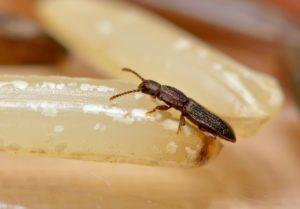Grain lover: red flour eater
Many years ago, even before the start of active world trade, red flour-eaters lived quietly in tropical forests and ate decaying wood. But since then the world has changed a lot. Thanks to merchant ships, this type of insect has spread almost everywhere and has received the title of one of the most dangerous food pests.
Content
Who is a red mukoed
Name: Red Surinamese flour eater
Latin: Cryptolestes ferugineus Steph.Class: Insects - Insecta
Squad: Coleoptera - Coleoptera
Family: Flat-tailers - Cucuidae
 | Habitats: | in the premises |
 | Dangerous for: | bulk products, dried fruits |
 | Means of destruction: | chemicals and folk methods |
The red Surinamese flour beetle or sawtooth grain beetle is a member of the sylvanid family. It's tiny bugs, the average length of which is about 1,5-2,5 mm.
The body is elongated, yellow-orange in color and densely covered with short hairs.
The antennae of the insect are bead-like and long, sometimes they can have the same length as the body.
Red flour-eaters can fly perfectly thanks to well-developed wings.
Adult larvae of the mucoed can reach 3 mm in length. The body is cream colored and covered with long, fine hairs. The tip of the abdomen has a reddish tint and two hook-shaped outgrowths.
The pupa can be half the size of the larva. At this stage, the insect retains long hairs on the body, and a light beige color. Hook-shaped outgrowths at the tip of the abdomen straighten out and become more like spikes.
The habitat of the red mucoed
This pest of food stocks is familiar almost all over the world. Despite the fact that initially the red flour-eater lived exclusively in a tropical climate, in the modern world it has adapted well to life at lower temperatures.
The beetle moved from the wild closer to humans and became a frequent guest of such premisesAs:
- food warehouses;
- granaries;
- mills;
- bakeries;
- factories for the production of cereals and animal feed.
On the territory of Russia, the mucoed can be found in the following regions:
- Moscow region and the European part of the country;
- North Caucasus and southern regions;
- The Urals;
- Siberia;
- Far East.
Also, this species is widely distributed on the territory of the Australian continent, and in the countries of the Mediterranean, Europe and Asia.
What harm does the red mucoed
Before flour eaters left the tropics and became dangerous pests, their diet consisted mainly of rotten wood, mold and mealybug excretions.
For this reason, they are not adapted to feeding on whole, hard grains and most often settle in rooms with very high humidity, or where other pests have already visited before them. Main the menu of the red flour-eater consists of such products:
- rotting flour;
- damaged grains;
- dried fruits and vegetables;
- damp seeds and nuts;
- pasta.
A flour-eater that has settled in food stocks very quickly increases the number of its colony, which, in turn, actively clogs flour and cereals with waste products.
Products in which the red flour-eater has visited become unsuitable for human consumption and are subject to complete destruction.
How the red flour eater gets into houses
Most often, products enter residential buildings already infected, and in most cases they contain not adult beetles or larvae, but tiny eggs of pests. Usually, the flour eater enters homes with such types of food as:
- cereals;
- flour;
- food for poultry and animals.
In rare cases, infection can occur due to the fault of an adult bug that flew into the window. Due to their tiny size, it can be very difficult to immediately notice them, so the presence of a pest becomes obvious only when the products on the shelves are already spoiled.
How to get rid of a red flour eater in the house
On an industrial scale, people regularly fight flour eaters and other pests, and most often they use the services of professionals for this. But, if the flour eater settled on the kitchen shelf of a private house or apartment, then this method may turn out to be unreasonably expensive.
When noticing signs of the presence of this tiny pest, the first thing to do is to throw away or destroy all contaminated food.
Attempts to sift or select visually “clean” cereals will be useless, since beetle eggs are so tiny that it is almost impossible to notice their presence even in snow-white flour. Only after the food base of the insect is destroyed, you can proceed to surface treatment.
Folk remedies
Before moving on to the “heavy artillery” and applying chemicals, many people first try to get rid of the pest using folk recipes. The best effect among them, gives an impact on insects with a pungent odor. To do this, on the shelves you can lay out:
- garlic cloves and husks;
- cotton pads soaked in essential oils;
- bay leaves;
- nutmeg;
- dried herbs with a strong odor.
Chemicals
If folk remedies did not help in solving the problem, then you should resort to the help of insecticides. Proven and effective home pest control products are:
- Raptor;
- Dichlorvos;
- Combat;
- RAID.
Conclusion
The fate of the red flour-eater is in some ways very similar to the history of the Colorado potato beetle, which also lived carelessly within its small range until people disturbed it. The original habitat of the red flour-eater was tropical forests and there was no question of any of its harmfulness. But, over time, these insects went beyond their natural habitat and realized that it is much more profitable for them to settle near a person.
Previous

